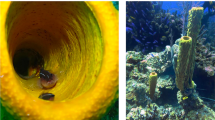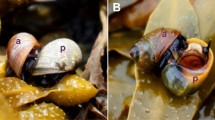Abstract
Opportunity and recognition isolation can lead directly to reproductive isolation, the former via divergence in the location and timing of breeding, and the latter via differential mate preferences. We describe the potential significance of these factors in the maintenance of reproductive isolation in a clade of triplefin fishes that occur sympatrically around coastal New Zealand. Specifically, we investigate the roles of spawning time and nesting habitat in promoting opportunity isolation, and of interspecific variation in male body length and breeding colouration in promoting recognition isolation. The triplefin species investigated are reproductively active over several months and show high overlap in breeding times, thus rejecting temporal isolation as a mechanism. Differences in nesting habitats resulted in a reduced probability of encounter between some species, especially between sister-species pairs. Interspecific colour differences generally decreased during the reproductive period, and males of sister-species pairs showed no interspecific colour differences in the ultraviolet light spectrum, thus mate selection based on male colour patterns is unlikely to lead to premating isolation. Finally, males of closely related triplefin species differed in body length, a secondary sexual trait often involved in assortative mating. Thus, spatial differences in nesting habitats reduce the chances of encountering allospecific mates, which may facilitate opportunity isolation and differences in male length, possibly related to species-specific female selection on male body size, may lead to recognition isolation. The combination of limited spatial overlap in nesting habitat and differences in male body size may facilitate species assortative mating in sympatry or parapatry.






Similar content being viewed by others
References
Allender CJ, Seehausen O, Knight ME, Turner GF, Maclean N (2003) Divergent selection during speciation of Lake Malawi cichlid fishes inferred from parallel radiations in nuptial colouration. Proc Natl Acad Sci USA 100:14074–14079
Alonzo SH, Warner RR (1999) A trade-off generated by sexual conflict: Mediterranean wrasse males refuse present mates to increase future success. Behav Ecol 10:105–111
Alonzo SH, Warner RA (2000) Dynamic games and field experiments examining intra- and intersexual conflict: explaining counterintuitive mating behavior in a Mediterranean wrasse, Symphodus ocellatus. Behav Ecol 11:56–70
Ayling T, Cox GC (1987) Collins guide to the sea fishes of New Zealand. Collins, Auckland
Bekkevold D, André C, Dahlgren TG, Clausen LAW, Torstensen E, Mosegaard H, Carvalho GR, Christensen TB, Norlinder E, Ruzzante DE (2005) Environmental correlates of population differentiation in Atlantic herring. Evolution 59:2656–2668
Blouw DM, Hagen DW (1990) Breeding ecology and evidence of reproductive isolation of a widespread stickleback fish (Gasterosteidae) in Nova Scotia, Canada. Biol J Linnean Soc 39:195–217
Bolnick DI, Doebeli M (2003) Sexual dimorphism and adaptive speciation: two sides of the same ecological coin. Evolution 57:2433–2449
Boughman JW (2001) Divergent sexual selection enhances reproductive isolation in sticklebacks. Nature 411:944–948
Boughman JW, Rundle HD, Schluter D (2005) Parallel evolution of sexual isolation in sticklebacks. Evolution 59:361–373
Clements KC (2003) Triplefins. In: Andrew N, Francis M (eds) The living reef. The ecology of New Zealand’s rocky reefs. Craig Potton Publishing, Nelson, pp 160–167
De Jonge J, Videler JJ (1989) Differences between the reproductive biology of Tripterygion tripteronotus and T. delaisi (Pisces, Perciformes, Tripterygiidae): the adaptive significance of an alternative mating strategy and red instead of a yellow nuptial colour. Mar Biol (Berlin) 100:431–437
Dobzhansky T (1937) Genetics and the origin of the species. Columbia University Press, New York
Feary D (2001) Trophic morphology, diet and habitat use of New Zealand triplefins (Family Tripterygiidae). MSc Thesis. School of Biological Sciences, Auckland
Feary DA, Clements KC (2006) Habitat use by triplefin fishes (family Tripterygiidae) on rocky reefs in New Zealand. J Fish Biol 69:1031–1046
Francis MP (2001) Coastal fishes of New Zealand. An identification guide. Reed Books, Auckland
Fricke R (1994) Tripterygiid fishes of Australia, New Zealand and the Southwest Pacific Ocean (Teleostei). Koeltz Scientific Books, Königstein
Fryer G, Iles TD (1972) The cichlid fishes of the great lakes of Africa: their biology and evolution. Oliver and Boyd, London
Fuller RC (2002) Lighting environment predicts the relative abundance of male colour morphs in blue killifish (Lucania goodei) populations. Proc Roy Soc Biol Sci Ser B 269:1457–1465
Gavrilets S (2004) Fitness landscapes and the origin of species. Princeton University Press, New Jersey
Geertjes GJ, Videler JJ (2002) A quantitative assessment of the reproductive system of the Mediterranean cave-dwelling triplefin blenny Tripterygion melanurus. Mar Ecol 23:327–340
Gilligan MR (1991) Bergmann ecogeographic trends among triplefin blennies (Teleostei: Tripterygiidae) in the Gulf of California, Mexico. Environ Biol Fishes 31:301–305
Greenwood PH (1974 ) Cichlid fishes of Lake Victoria, East Africa: the biology and evolution of a species flock. Bull Br Museum (Natural History) Zool Suppl 6:1–134
Hendry AP, Troy D (2005) Population structure attributable to reproductive time: isolation by time and adaptation by time. Mol Ecol 14:901–916
Hendry AP, Berg OK, Quinn TP (2001) Breeding location choice in salmon: causes (habitat, competition, body size, energy stores) and consequences (life span, energy stores). Oikos 93:407–418
Hendry AP, Morbey YE, Berg OK, Wenburg JK (2004) Adaptive variation in senescence: reproductive lifespan in a wild salmon population. Proc Roy Soc Biol Sci Ser B 271:259–266
Hickey AJR (2004) Evolution of New Zealand’s triplefin fish (Family Tripterygiidae). PhD thesis. School of Biological Sciences, Auckland
Hickey AJR, Clements KC (2005) Genome size evolution in New Zealand triplefin fishes. J Heredity 7:356–362
Hickford MJH, Schiel DR (2003) Comparative dispersal of larvae from demersal versus pelagic spawning fishes. Mar Ecol Progress Ser 252:255–271
Jamieson IG, Blouw DM, Colgan PW (1992) Field observations on the reproductive biology of a newly discovered stickleback (Gasterosteus). Can J Zool 70:1057–1063
Jordan R, Kellogg K, Juanes F, Howe D, Staufferals J Jr, Loew ER, Losey GS (2004) Ultraviolet reflectivity in three species of Lake Malawi rock-dwelling cichlids. J Fish Biol 65:876–882
Lindström K (1992) Female spawning patterns and male mating success in the sand goby Pomatoschistus minutus. Mar Biol (Berlin) 113:475–480
Longenencker K, Langston R (2005) Life history of the Hawaiian blackhead triplefin, Enneapterygius atriceps (Blennioidei, Tripterygiidae). Environ Biol Fishes 73:243–251
Lu G, Bernatchez L (1999) Correlated trophic specialisation and genetic divergence in sympatric lake whitefish ecotypes (Coregonus clupeaformis): support for the ecological speciation hypothesis. Evolution 53:1491–1505
Mayr E (1970) Populations, species, and evolution. An abridgement of animal species and evolution. The Belknap Press of Harvard University Press, Cambridge
McKaye KR (1986) Mate choice and size assortative pairing by the cichlid fishes of Lake Jiloá, Nicaragua. J Fish Biol 29:135–150
McKinnon JS, Mori S, Blackman BK, David L, Kingsely DM, Jamieson L, Chou J, Schluter D (2004) Evidence for ecology’s role in speciation. Nature 429:294–298
Munday PL, Herwerden Lv, Dudgeon CL (2004) Evidence for sympatric speciation by host shift in the sea. Curr Biol 14:1498–1504
Nagel L, Schluter D (1998) Body size, natural selection, and speciation in sticklebacks. Evolution 52:209–218
Neat FC (2001) Male parasitic spawning in two species of triplefin blenny (Tripterygiidae): contrasts in demography, behaviour and gonadal characteristics. Environ Biol Fishes 61:57–64
Palstra AP, De Graaf M, Sibbing FA (2004) Riverine spawning in a lacustrine cyprinid species flock, facilitated by homing? Anim Biol 54:393–415
Palumbi SR (1998) Species formation and the evolution of gamete recognition loci. In: Howard D, Berlocher S (eds) Endless Forms: species and speciation. Oxford University Press, New York, pp 271–278
Paulin CD, Roberts CD (1992) The rockpool fishes of New Zealand. Museum of New Zealand, Te Papa
Pickard R (2000) Fetch effect analysis computer program, version 1.01
Quinn TP, Unwin MJ, Kinnison MT (2000) Evolution of temporal isolation in the wild: genetic divergence in timing of migration and breeding by introduced Chinook salmon populations. Evolution 54:1372–1385
Ratcliffe LM, Grant PR (1983) Species recognition in Darwin’s finches (Geospiza,Gould). I. Discrimination by morphological cues. Anim Behav 31:1139–1153
Rice WR (1985) Disruptive selection on habitat preference and the evolution of reproductive isolation: an exploratory experiment. Evolution 39:645–656
Rice WR, Salt GW (1988) Speciation via disruptive selection on habitat preference: experimental evidence. Am Nat 131:911–917
Rice WR, Salt GW (1990) The evolution of reproductive isolation as a correlated character under sympatric conditions: experimental evidence. Evolution 44:1140–1152
Ruck JG (1973) Development of Tripterygion capito and T. robustum (Pisces: Tripterygiidae). Zool Publ Victoria Univ Wellington 63:1–10
Ruck JG (1980) Early development of Forsterygion varium, Gilloblennius decemdigitatus, and G. tripennis (Pisces: Tripterygiidae). N Z J Mar Freshw Res 14:313–326
Rundle HD, Nagel L, Boughman JW, Schluter D (2000) Natural selection and parallel speciation in sympatric sticklebacks. Science 287:306–308
Ryan MJ (2001) Food, song and speciation. Nature 409:139–140
Sargent RC, Rush VN, Wisenden BD, Yan HY (1998) courtship and mate choice in fishes: integrating behavioral and sensory ecology. Am Zool 38:82–96
Schliewen UK, Rassmann M, Markmann J, Markert T, Kocher DT (2001) Genetic and ecological divergence of a monophyletic cichlid species pair under fully sympatric conditions in Lake Ejagham, Cameroon. Mol Biol 10:1471–1488
Scott RJ (2001) Sensory drive and nuptial colour loss in the three-spined stickleback. J Fish Biol 59:1520–1528
Seehausen O (2006) African cichlid fish: a model system in adaptive radiation research. Proc Roy Soc Biol Sci Ser B 273:1987–1998
Seehausen O, van Alphen JJM (1998) The effect of male colouration on female mate choice in closely related Lake Victoria cichlids (Haplochromis nyererei complex). Behav Ecol Sociobiol 42:1–8
Seehausen O, Van Alphen JJM, Witte F (1997) Cichlid fish diversity threatened by eutrophication that curbs sexual selection. Science 277:1808–1811
Smith EJ, Partridge JC, Parsons KN, White EM, Cuthill IC, Bennet ATD, Church SC (2002) Ultraviolet vision and mate choice in the guppy (Poecilia reticulata). Behav Ecol 13:11–19
Streelmann JT, Danley PD (2003) The stages of vertebrate evolution. Trends Ecol Evolut 18:126–131
Syms C (1995) Multi-scale analysis of habitat association in a guild of blennioid fishes. Mar Ecol Progress Ser 125:31–43
Thompson SM (1979) Ecological and behavioural factors influencing the distribution and abundance patterns of tripterygiid fishes with particular reference to Tripterygion varium. MSc thesis, Zoology, Auckland
Thompson S (1986) Male spawning success and female choice in the mottled triplefin, Forsterygion varium (Pisces: Tripterygiidae). Anim Behav 34:580–589
Wellenreuther M, Barrett PT, Clements KD (2007a) Ecological diversification in habitat use in subtidal triplefin fishes (Trepterygiidae). Mar Ecol Progress Ser 330:235–246
Wellenreuther M, Syms C, Clements KD (2007b) The role of body size in ecological diversification and reproductive isolation in a sister species pair of triplefin fishes. Evol Ecol (in press). doi:10.1007/s10682-007-9183-7
Wirtz P (1978) The behaviour of the Mediterranean Triperygion species (Pisces, Blennioidei). Zeitschrift für Tierpsychologie 48:142–174
Zimmer RK, Butman CA (2000) Chemical signalling processes in the marine environment. Biol Bull (Woods Hole) 198:168–187
Acknowledgments
We would like to thank B. Doak and M. Birch for skippering the R.V. Hawere, and Z. Hilton and D. Moran for help with fieldwork. C. Syms has considerably improved the statistics used in this paper. We thank B. Doak, I. Skipworth and R. Armstrong for photographs of triplefin species and J. Marshall and K. Fritsches for advice on how to measure ultraviolet colour patterns. We would also like to thank P. Munday and three anonymous reviewers for helpful comments on the manuscript. M. Wellenreuther was funded by a Top Achiever Doctoral Scholarship from the Tertiary Education Commission of the New Zealand government and a doctoral scholarship from the University of Auckland. This research was supported by a Marsden grant from the New Zealand Royal Society to K. D. Clements.
Author information
Authors and Affiliations
Corresponding author
Additional information
Communicated by S. D. Connell.
Rights and permissions
About this article
Cite this article
Wellenreuther, M., Clements, K.D. Reproductive isolation in temperate reef fishes. Mar Biol 152, 619–630 (2007). https://doi.org/10.1007/s00227-007-0713-1
Received:
Accepted:
Published:
Issue Date:
DOI: https://doi.org/10.1007/s00227-007-0713-1




